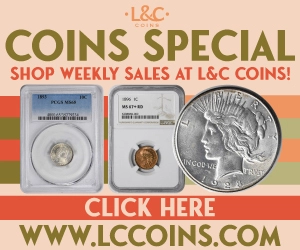By Blanchard and Company, Inc ……
The United States Trade Dollar is an interesting example of how expanding global trade can give rise to new coins.
In the mid-1800s, the Mexican peso was a highly valued means of exchange in China. In contrast, the American silver dollar was far less popular due to its relatively light weight. This meant that American merchants had no choice but to use Mexican and Spanish currency when engaging in commerce.
Around this time, Louis Garnett, who served as both Treasurer and Assayer of the San Francisco Mint, suggested that the U.S. create a new commercial dollar for export to East Asia. The intent was for this new coin to compete with other trade coins that were already well-established in those areas.
By 1872, there was a bill before Congress seeking authorization for such a coin. Around the same time, the Mint began to strike several commercial Trade Dollar designs in preparation for the new piece upon passage of the bill. Eventually, it was decided that the design would show Liberty as represented by a seated figure facing left, in the direction of East Asia. The obverse showed a bald eagle as required by law. Interestingly, the image of the eagle on this coin was a reversal of most other coins of the era given that the eagle held three arrows in its right claw and an olive branch in its left.
After the coin was minted and circulated, Henry Linderman, American financier and Superintendent of the United States Mint, ordered a review of the coin’s acceptance in China. He learned that the coin was fairly well circulated in southern China but failed to experience widespread usage in the north.
Around this same time, Congress passed the Specie Redemption Act, which gave the Treasury Department permission to pay silver coins in exchange for paper currency. This decision, coupled with a drop in silver prices, led to an increase of silver coins in American transactions and Trade Dollars started flowing back into the United States. Soon, the intrinsic value of the coin sunk below one dollar, and by late July of 1876, Congress passed a bill that officially demonetized it.
Despite this, Trade Dollars remained in circulation and some employers in the U.S. started paying workers with them, as they could be purchased at a discount as the price of silver dropped. In response, many towns set a fixed value on the coins. Problems intensified as bullion prices continued to drop through the 1880s, which exacerbated losses among those who paid face value and ultimately were forced to sell at melt value.
Eventually, Trade Dollars were arguably once again made legal tender upon passage of the Coinage Act of 1965. Today, the bullion and numismatic value of the Trade Dollar is greater than its face value of one dollar.
These coins, consisting of 90% silver and 10% copper, represent the confluence of change seen in American commerce in the late 1800s when commodity process, competing currencies, and international trade all influenced the fate of the Trade Dollar.
